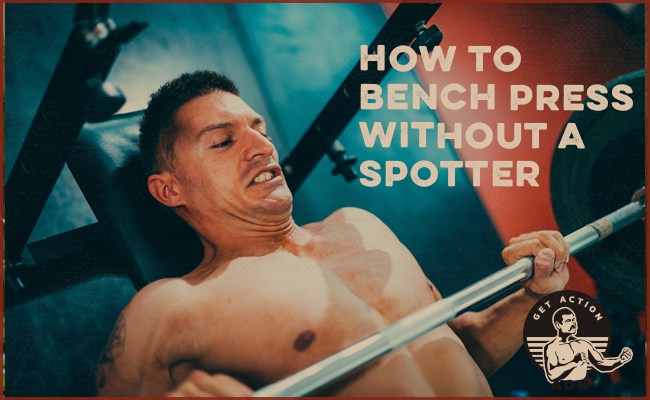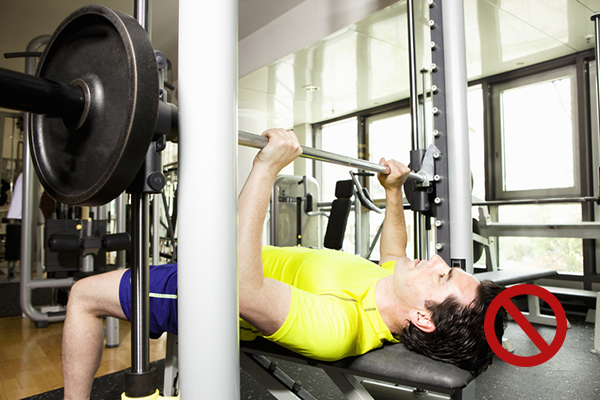
Of all the main barbell lifts, the bench press is the most dangerous. In fact, it can kill you.
If the bar slips from your hands during the lift, the loaded barbell can fall on your face, throat, or chest, ending your life relatively quickly.
Or let’s say you don’t drop the bar but can’t lift it up after it touches your chest. A barbell on your chest can roll down on your neck and strangle you. Or it can roll down your belly, mashing your soft internal organs and possibly tearing an artery, resulting in you bleeding out.
Because the bench press can potentially kill you, it’s highly recommended that you perform the bench press with a spotter. (Here’s how to spot someone on the bench press). If you fail a lift, they can quickly assist in getting the barbell off your body.
But what do you do if there isn’t a spotter around? Perhaps you work out by yourself in your home gym, where the only potential spotter is your seven-year-old daughter. Do you just forgo benching?
I say unto you, nay. Thou canst still bench.
You just need to follow some precautionary rules so you can perform the lift safely and avoid death by barbell.
Rule #1: Never Put Collars on Your Barbell When You Bench

Collars prevent the weight plates from sliding off the barbell while performing various lifts. They keep you and those around you safe while you do so. No one wants to be around a lifter who has four 45-lb plates slide off the barbell sleeve during the middle of their shoulder press or squat. Also, by preventing the plates from sliding around, collars help make your lifts more efficient. Things get harder when the equilibrium of the weight shifts towards the ends of the bar and it becomes unbalanced.
So always put collars on your barbell . . . except when you’re bench pressing.
Here’s why: If you find yourself unable to lift the bar off your chest, you can tilt your body to either side and let the weights slide off the ends. Disaster averted.
I even bench press without collars when I do have a spotter. If the spotter can’t help you lift the bar off your chest because it’s too heavy, they’ll at least be able to help you tilt the barbell to one side so the weights can slide off the sleeves.
Rule #2: Always Take a Thumbs-Around Grip on the Barbell

Lots of dudes like to take a thumbless grip around the barbell when benching. It admittedly feels a bit more comfortable on the wrists.
But there’s a reason why the thumbless grip is also called the “suicide grip.” If the barbell slips in your hand, there’s no thumb in the way to prevent it from slipping right out of your hands and crashing on your face or chest.
Dead.
Thumbs around the barbell at all times when you’re bench pressing.
Rule #3: Always Use Safety Arms or Pins

If you’re benching alone, never bench without a power rack that you can attach safety arms or pins to.
Set the safety pins or arms so that they’re slightly lower than where the barbell would be when touching your chest. If you can’t get the barbell off your chest, you simply sink your chest a bit or roll the barbell towards your face and let it rest on the pins or arms. With the weight of the barbell off you, you can shimmy out between the barbell and the bench to safety.

Make sure the pins or arms are set at the correct height before you start loading the barbell — you don’t want to find out you set them too low when you need them most.
Rule #4: Never Use a Smith Machine to Bench Press

A Smith machine is a weight machine in which a barbell is fixed within steel rails, allowing for only vertical movement. Along the rail is a series of slots or pegs. Affixed to the barbell at each end are hooks that will enable the barbell to be racked at any point along the rail by merely twisting the wrists back and catching the hooks on the slots or pegs. The Smith machine may seem to be a self-spotting device; if the barbell gets stuck on your chest or neck, just flick the wrists back to rack it into one of the slots.
But this device is not as safe as it appears and can give a lifter a false sense of confidence. The bar on a Smith machine can stop in a position between the slots, preventing you from safely racking it. And because the barbell is fixed within two vertical steel rails, you can’t tip it to one side or the other to slide the weights off the ends. As a consequence, the Smith machine can become a death trap.
This is no hyperbole; my barbell coach had a cousin who died while benching in a Smith machine. He lowered the barbell down, it came to rest on his neck, and he couldn’t lift it back up; he was unable to rack it into a slot, nor to slide the plates off the bar. He suffocated to death in 27 minutes.
This tragedy isn’t an isolated incident; the Smith machine has been responsible for a number of other deaths. Don’t use one.
The bench press is a dangerous lift. Respect it. Use a spotter when possible. If no spotter is available, follow the above four rules to bench press safely.


